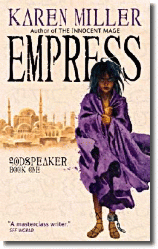Craig Johnson
Craig Johnson is the author of the Walt Longmire mysteries: The Cold Dish, Death Without Company, Kindness Goes Unpunished and Another Man’s Moccasins.
From an "interrogation" at Johnson's website:
Who is Walt based on? Henry? Vic?Read more of the Q & A.
I agree with Wallace Stegner that the greatest fraud perpetrated on the reading public is the statement at the beginning of each novel that states that this is a work of fiction and that any similarity to persons living or dead… What a crock. I'm always looking for traits, turns of phrase, anything that might help me inform my characters; it's all grist for the mill.
Walt is special because he's the voice of the book, the head that you have to be inside for hundreds of pages; so, he better be honest and be real. I think that the reading public is pretty smart; they can tell if you're on thin ice. I try and keep Walt close and, while I wouldn't say he was me, I'd say he was closer, on a whole, than any of the other characters. He's who I'd like to be in about ten years, but I'm off to an awfully slow start… I assembled him, to a certain extent, from a lot of my experiences and from a lot of the individuals that I worked with in law enforcement. I basically tried to engender a sheriff that embodied all the best qualities of police work that I could think of: compassion, intelligence, dogged determination, and strong sense of right and wrong.
Henry is a composite character who I developed from two very close friends, one a Lakota Sioux the other a Cree. They're both pretty incredible guys with great senses of humor and a kind of wistful spirituality that gives me an ability to explore areas that Walt might otherwise leave untouched. I think a lot of writers make the same mistake with Indians that they do with cops, forgetting that they're people.
Vic? Where do I start? I needed an urban voice in The Cold Dish , and I was interested in making her a different kind of character than what you might assume to live in Absaroka County, Wyoming. I needed somebody who was savvy and smart and being kind of sexy wasn't a necessarily a bad thing…
Why did you make Walt's deputy a woman?
Sexual tension. Even with the difference in age and background, I thought it might be more interesting if they had this unrequited relationship, the potential of something happening even if it never did. I also needed a female voice to balance out the weight of the masculine narrative. I've always thought, like Walt, that life is infinitely more interesting with women around.
The Page 69 Test: Kindness Goes Unpunished.
My Book, The Movie: The Cold Dish.
--Marshal Zeringue































